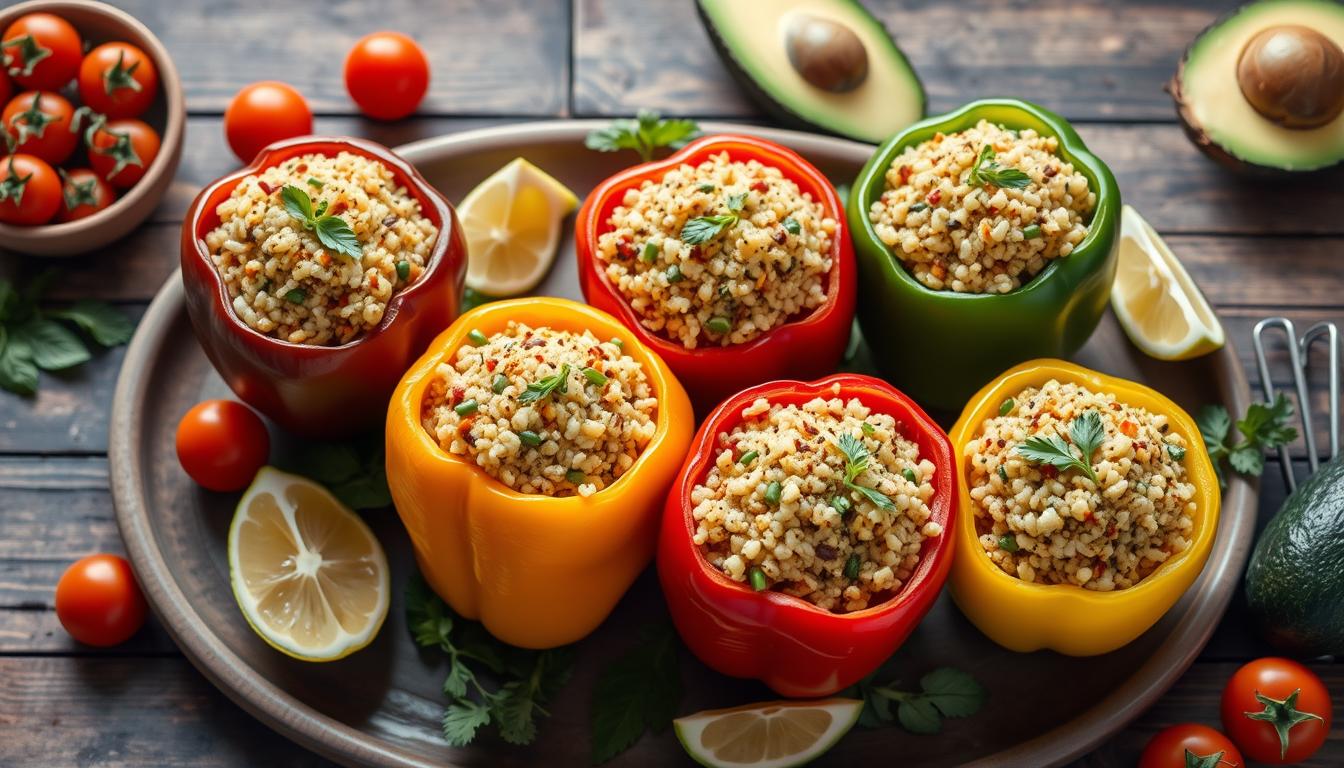Imagine a dish that’s both tasty and packed with nutrients. It meets the special dietary needs of those with endometriosis. Could quinoa-stuffed peppers be the perfect choice? It’s surprising that up to 80% of people with irritable bowel syndrome (IBS) might feel better on a low FODMAP diet.
This diet is key for those with endometriosis. Let’s see how this recipe can change your meal planning for the better.
The low FODMAP diet’s first phase lasts 4-8 weeks. Even small amounts of high FODMAP foods can affect its success. By adding this dish to your meals, you’re helping manage your endometriosis symptoms. It’s a step towards better health.
Low FODMAP Quinoa-Stuffed Peppers: A Nutritious Delight
Our endo friendly quinoa-stuffed peppers make it easy to enjoy a healthy, plant-based meal. This dish is perfect for those on a low FODMAP diet. It’s also full of flavor and satisfying.
Embrace a Nourishing Plant-Based Meal
Quinoa is the star of this recipe. It’s packed with protein, fiber, and vitamins. It’s a great choice for a gluten-free and healthy meal prep option.
Quick, Easy, and Endometriosis-Friendly
Our endo friendly quinoa-stuffed peppers are easy to make. They use simple, healthy ingredients and are quick to cook. They’re great for busy days or meal prep. They’re also good for those with endometriosis.
Try our endo friendly quinoa-stuffed peppers for a burst of flavor and texture. This gluten-free recipe highlights quinoa and fresh veggies. It’s a nutritious treat that meets your dietary needs.
Endo Friendly Quinoa-Stuffed Peppers: A Nutrient-Dense Dish
Our endo friendly quinoa-stuffed peppers recipe is a nutritious treat for those with endometriosis. It uses quinoa, a gluten-free grain packed with protein, fiber, and vitamins. This nutrient-dense dish is a healthy choice to support your health and well-being.
Quinoa is a great source of plant-based protein, with all nine essential amino acids. It’s also high in fiber, which can boost microbial diversity and lower inflammation. This is key for those with endometriosis. Plus, quinoa’s low glycemic index helps keep blood sugar stable, which is vital in an endometriosis diet.
Our recipe also includes other anti-inflammatory ingredients like fresh herbs, spices, and healthy fats. These ingredients combine to make a tasty and nourishing meal. It can help ease symptoms of endometriosis.
Choosing nutrient-dense dishes like our quinoa-stuffed peppers can help manage endometriosis. It’s a step towards improving your overall health. Always talk to healthcare professionals or nutritionists for advice on an endometriosis diet that suits you.
Benefits of Quinoa for the Low FODMAP Diet
Quinoa is a great choice for those on a low FODMAP diet. It’s gluten-free, high in protein, and full of fiber. These qualities make it a nutritious option for those with endometriosis. Adding quinoa to your meals, like these tasty quinoa-stuffed peppers, helps you stick to a low FODMAP diet. It also makes your meals more satisfying and healthy.
Gluten-Free, High in Protein, and Fiber-Rich
Quinoa is a versatile and nutritious grain that’s naturally gluten-free. This makes it perfect for those on a low FODMAP diet. It’s also packed with protein and fiber. These nutrients help keep you energized, support your digestive health, and have anti-inflammatory effects. All these benefits are key for managing endometriosis.
| Nutrient | Quinoa | Other Grains |
|---|---|---|
| Protein | 8g per cup | 4-6g per cup |
| Fiber | 5g per cup | 2-3g per cup |
| Gluten | Gluten-free | May contain gluten |
Choosing quinoa for your low FODMAP diet means you get a nourishing and versatile grain. It supports your health and wellness while following the dietary guidelines for managing endometriosis.
Why the Low FODMAP Diet for Endometriosis?
Living with endometriosis can be tough. Symptoms often feel like a constant battle. But, research shows the low FODMAP diet might help. It’s a diet that can ease stomach pain and lower inflammation, common problems for those with endometriosis.
This diet limits certain carbs that can upset the stomach. Many people with endometriosis find it helps them feel better and have fewer flare-ups. Our quinoa-stuffed peppers recipe is a tasty example of what a low FODMAP diet can offer.
Adding a low FODMAP diet to your treatment plan can be very helpful. It focuses on the gut issues that often come with endometriosis. This can give much-needed relief and help you take charge of your health.
| Key Benefits of the Low FODMAP Diet for Endometriosis |
|---|
|
By using the low FODMAP diet, people with endometriosis can take a big step towards feeling better. Our Quinoa-Stuffed Peppers recipe shows how to enjoy tasty, endometriosis-friendly meals while following this diet.
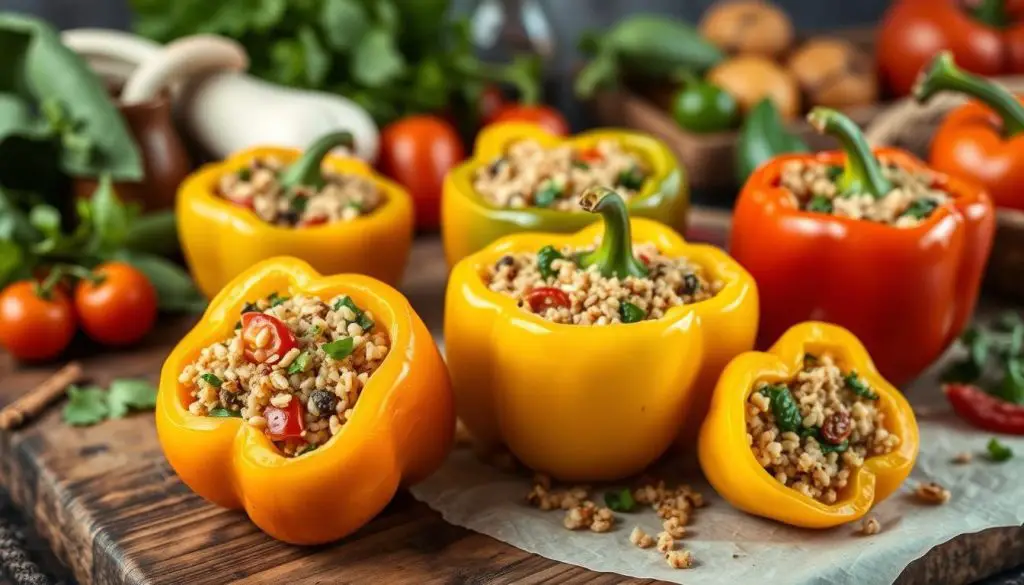
Preparing Quinoa-Stuffed Peppers: A Step-by-Step Guide
Making our tasty quinoa-stuffed peppers is quite simple. We use easy-to-find ingredients to make a healthy dish that’s good for your body.
Simple Ingredients, Flavorful Results
We start with quinoa, a superfood, as the base. Then, we sauté veggies like bell peppers, zucchini, and spinach. This adds flavor and nutrients to our dish.
We add lean ground beef or turkey, pasta sauce, Italian seasoning, and Parmesan cheese and nutritional yeast for extra protein. After mixing everything, we fill bell pepper halves with it. We finish with a sprinkle of mozzarella cheese.
- Preheat your oven to 375°F (190°C).
- Cook the quinoa as the package says, and set it aside.
- In a skillet, cook the ground meat until it’s browned and done.
- Add the chopped veggies, pasta sauce, Italian seasoning, and a bit of salt and pepper. Cook until the veggies are soft.
- Mix in the cooked quinoa and grated Parmesan cheese.
- Cut the bell peppers in half lengthwise and remove the seeds and membranes.
- Fill the pepper halves with the quinoa-veggie mix.
- Top the peppers with shredded mozzarella cheese.
- Bake the peppers for about 60 minutes, or until they’re soft and the cheese is melted.
Enjoy your delicious quinoa-stuffed peppers. This meal is not only tasty but also good for your health. It shows how simple, healthy ingredients can make a great dish.
| Ingredient | Amount |
|---|---|
| Quinoa | 1 cup |
| Ground beef or turkey | 1 lb |
| Bell peppers | 6 medium |
| Pasta sauce | 1 cup |
| Zucchini | 1 medium |
| Power greens or spinach | 2 cups |
| Mozzarella cheese | 1 cup |
| Parmesan cheese | 1/4 cup |
| Italian seasoning | 2 tsp |
| Nutritional yeast | 2 tbsp |
| Salt and pepper | to taste |
Customizing Your Stuffed Peppers: Tasty Variations
Our quinoa recipes are a great start, but feel free to make them your own. You can change the quinoa to another gluten-free grain. Add different veggies or try new spices. This way, you can make a dish that you love and helps with endometriosis.
Try using farro or bulgur instead of quinoa for more protein. Add roasted zucchini, eggplant, or more bell peppers for extra nutrients and color. Experiment with spices like smoked paprika, cumin, or oregano to boost the flavor.
Focus on ingredients that fit your diet and taste when customizing your stuffed peppers. This way, you’ll find a gluten-free recipe that you’ll love and can eat often.
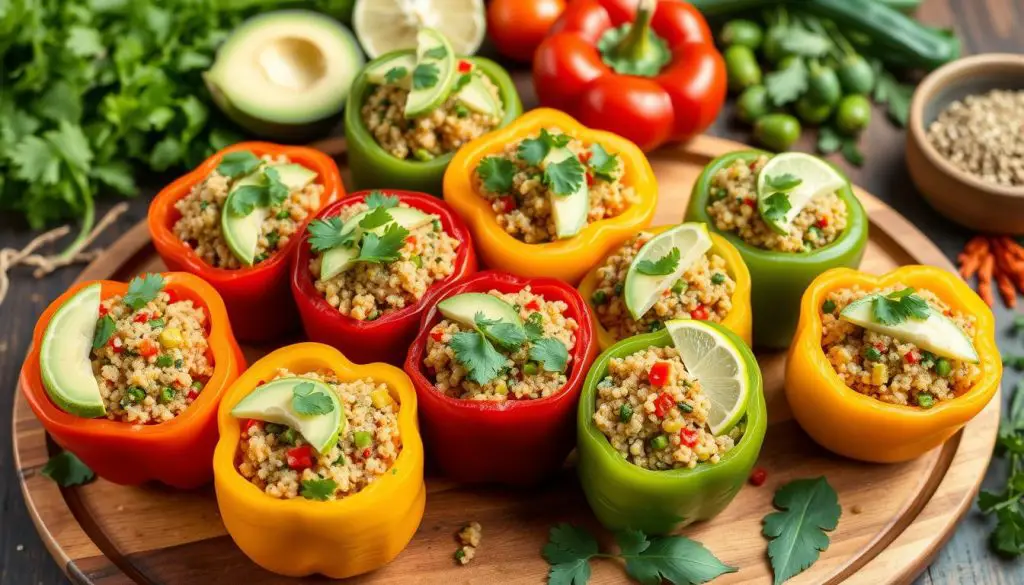
- Mediterranean Quinoa Stuffed Peppers: Use bulgur wheat instead of quinoa. Add diced tomatoes, cucumbers, feta cheese, and a lemon-garlic dressing.
- Southwest-Inspired Quinoa Stuffed Peppers: Use black beans and corn instead of quinoa. Season with chili powder, cumin, and top with avocado and salsa.
- Pesto Quinoa Stuffed Peppers: Make the quinoa with pesto. Stuff the peppers with roasted veggies like zucchini and eggplant.
- Mushroom and Spinach Quinoa Stuffed Peppers: Sauté mushrooms and spinach to mix into the quinoa. This adds earthy flavors and nutrients.
There are countless ways to customize your stuffed peppers. Let your creativity run wild and find the perfect mix for you.
Quinoa-Stuffed Peppers: A Meal Prep Game-Changer
Preparing quinoa-stuffed peppers is a big help for those with endometriosis. These tasty, endo-friendly peppers are a great low FODMAP meal. They support your health and well-being.
Quinoa-stuffed peppers are easy to make ahead. They’re full of flavor and can be enjoyed all week. This saves time and ensures you get the nutrients you need to fight endometriosis symptoms.
Using healthy meal prep with dishes like quinoa-stuffed peppers is a big win. It helps those with endometriosis manage their diet. Having these tasty, endo-friendly meals ready makes it easier to nourish your body.
Why not make your meal prep easier? Add quinoa-stuffed peppers to your weekly meals. They bring convenience and nourishment to your endometriosis journey.
Anti-Inflammatory Foods for Endometriosis Management
Endometriosis can be tough to handle, but eating anti-inflammatory foods might help. Our quinoa-stuffed peppers recipe is low in FODMAP and packed with nutrients. These ingredients support your body’s healing.
Quinoa is the main ingredient, a gluten-free grain full of protein, fiber, and vitamins. Studies show quinoa might fight inflammation, making it great for an endometriosis diet.
The peppers, veggies, and herbs in our recipe also fight inflammation. Peppers have capsaicin, which lowers inflammation. Leafy greens, tomatoes, and herbs like basil and oregano are full of antioxidants. These help fight inflammation too.
Eating nutrient-dense dishes like our quinoa-stuffed peppers can help manage endometriosis. Adding more anti-inflammatory foods to your meals is a smart move. It’s a key part of managing endometriosis.
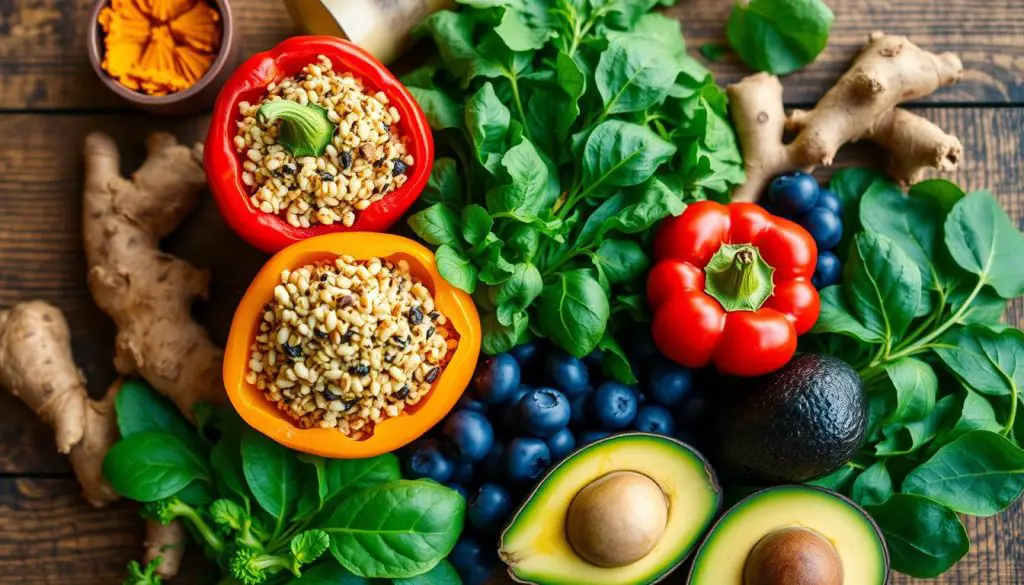
Every person with endometriosis is different. It’s key to work with your healthcare provider to find the right plan for you. With the right diet and support, you can find relief and feel better.
Low FODMAP Vegetarian Stuffed Peppers Recipe
Our low FODMAP quinoa-stuffed peppers recipe is perfect for vegetarians or vegans. It’s a meatless option that’s both delicious and satisfying. Quinoa replaces ground meat, making it a nutrient-rich dish that follows low FODMAP guidelines. It’s a great way to enjoy a low FODMAP, vegetarian meal that helps manage endometriosis.
Quinoa is the star of this recipe. It’s gluten-free and high in protein, making it low FODMAP. It adds a satisfying texture and boosts nutrition. We’ve also added low FODMAP vegetables, herbs, and spices to make the dish balanced and endometriosis-friendly.
Making the quinoa-stuffed peppers is easy. Start by cooking the quinoa as the package says. Then, clean and slice the bell peppers. Stuff them with the quinoa mix and bake until they’re perfect.
This recipe is also very flexible. You can add your favorite low FODMAP veggies like zucchini, spinach, or cherry tomatoes. Try different herbs and spices to match your taste. By following low FODMAP principles, you can enjoy a meal that’s good for your gut and overall health.
Remember, a low FODMAP diet is a personal journey. Always work with your healthcare provider or a registered dietitian to make sure you’re getting the nutrients you need. With a bit of creativity, you can find low FODMAP recipes like our quinoa-stuffed peppers that support your endometriosis management plan.
Gluten-Free, Plant-Based Meal Ideas for Endometriosis
There are many gluten-free and plant-based meals good for endometriosis. Eating whole, unprocessed foods helps your health. You can find lots of gluten-free recipes and plant-based meal ideas online. These can help you find more endo-friendly foods.
Try gluten-free smoothies or cereal for breakfast. Lunch and dinner can be plant-based salads, wraps, stuffed peppers, curries, and burgers. And don’t forget gluten-free desserts like chocolate-dipped bananas and date bars.
Adding gluten-free and plant-based meals to your endometriosis diet can be tasty and healthy. Try different recipes to find what you like and what fits your diet.
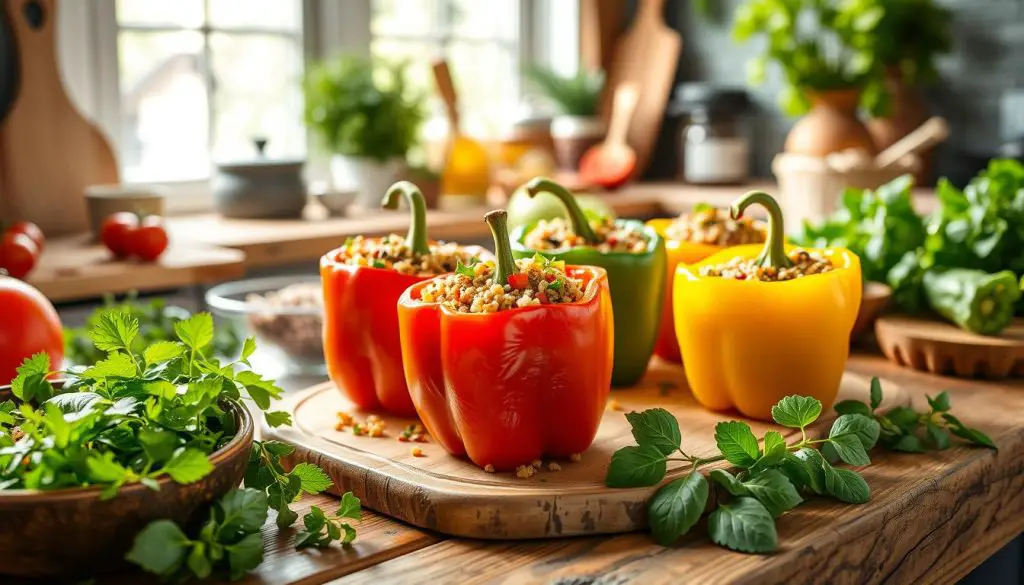
Eating a balanced diet with whole foods can really help with endometriosis. Look into gluten-free and plant-based meals online. Find the ones that are best for you.
Healthy Endo-Friendly Cooking: Tips and Tricks
Starting a endo-friendly cooking journey can be very empowering for those with endometriosis. Learning to make healthy, low FODMAP meals is a great way to take charge of your health. Our quinoa-stuffed peppers recipe is a great example of how to add healthy, anti-inflammatory foods to your endometriosis diet.
Empowering You to Thrive with Endometriosis
With the right knowledge, you can become a pro in the kitchen. You can make nutrient-dense dishes that help your body feel better. Here are some tips to help you improve your endo-friendly cooking skills and feel more confident in the kitchen.
- Embrace Meal Prep: Planning your meals for the week can save time and energy while ensuring access to nutritious, endometriosis-friendly options.
- Diversify Your Produce: Include a variety of fruits and vegetables in your diet to obtain a broad range of essential nutrients.
- Opt for Whole Grains: Incorporate whole grains like quinoa and brown rice, which are rich in fiber and beneficial for endometriosis management.
- Choose Lean Proteins: Lean proteins such as chicken, fish, tofu, and legumes are recommended for individuals with endometriosis.
- Harness Anti-Inflammatory Foods: Incorporate anti-inflammatory ingredients like fatty fish, leafy greens, and healthy fats to support hormone balance and reduce inflammation.
- Maintain Hydration: Proper hydration is key to managing endometriosis symptoms, so be mindful of incorporating hydrating foods and beverages into your daily routine.
By following these tips and focusing on endo-friendly cooking, you can take control of your endometriosis. You’ll nourish your body with every delicious, healthy meal.
Embrace Nutrient-Dense Dishes for Endometriosis Relief
Embracing nutrient-dense dishes can help manage endometriosis and its symptoms. These meals are full of vitamins, minerals, and anti-inflammatory properties. Our quinoa-stuffed peppers are a great example of such a dish, perfect for an endometriosis diet.
Endometriosis is complex and challenging. But, choosing nutrient-dense foods can help. Our quinoa-stuffed peppers, rich in anti-inflammatory foods, can support symptom management and overall health.
Let’s use nutrient-dense dishes to fight endometriosis and improve our lives. Adding more of these meals to our diets can help us take control and thrive with endometriosis.
Source Links
- https://desireerd.com/low-fodmap-diet-not-working-heres-why/
- https://geekgirllivingfit.wordpress.com/category/food/low-fodmap/
- https://www.julienutrition.com/introduce-vegetables-diet/
- https://crazyforyuca.com/tag/cassava/
- https://www.askamanager.org/2016/06/how-much-should-we-accommodate-employees-dietary-restrictions-at-work-events.html
- https://www.clairepettitt.com/blog/pcos-friendly-recipes-for-dinner-40-recipes-for-healthy-eating
- https://www.alextepperobgyn.com/your-guide-to-pregnancy-safe-foods-this-fall/
- https://www.everydayhealth.com/diet-nutrition/endomorph-diet/
- https://www.mindbodygreen.com/recipes
- https://www.everand.com/book/264132292/The-IBS-Healing-Plan-Natural-Ways-to-Beat-Your-Symptoms
- https://www.storytel.com/tv/books/endometriosis-cookbook-7-manuscripts-in-1-300-endometriosis-friendly-recipes-to-make-diet-easy-and-more-enjoyable-2619313
- https://www.drlamcoaching.com/blog/quinoa-salad/
- https://www.usenourish.com/blog/cheap-high-protein-meals
- https://www.loveandlemons.com/quinoa-bowl/
- https://www.usenourish.com/blog/7-day-meal-plan-for-pancreatitis
- https://healthyplatehappyfamily.com/category/vegetarian-2/
- https://www.everydayhealth.com/diet-nutrition/diet/vegan-diet-guide-benefits-risks-weight-loss-effect-food-list/
- https://samanthaelkrief.com/recipes/
- https://sofreshnsogreen.com/recipes/pcos-friendly-recipes/
- https://alisonjulie.com/30-different-plant-foods-a-week-low-fodmap/index.php
- https://greatist.com/eat/low-fodmap-recipes
- https://www.usenourish.com/blog/4-week-gut-protocol-meal-plan
- https://endometriosisnews.com/2018/08/02/nutrition-endometriosis-what-i-really-eat-day-part-2-lunch/
- https://chiavaye.com/blogs/endometriosis/endometriosis-diet-plan-recipes?srsltid=AfmBOop_HqZkY4k2Z-INwmWQWnmARFS7abxVUytc9rK8ibXxHgGoQB2I
- https://www.acibademhealthpoint.com/healthy-endometriosis-recipes-for-relief-comfort/
- https://thomasfuchscreative.com/blogs/news/all-that-remains?page=39
